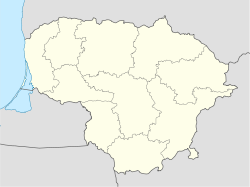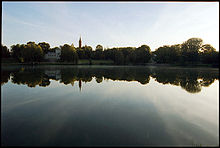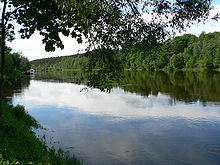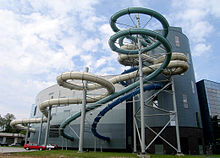- Druskininkai
-
Druskininkai — City — 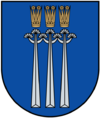
Coat of armsLocation of Druskininkai Coordinates: 54°1′N 23°58′E / 54.017°N 23.967°ECoordinates: 54°1′N 23°58′E / 54.017°N 23.967°E Country  Lithuania
LithuaniaEthnographic region Dzūkija County  Alytus County
Alytus CountyMunicipality Druskininkai municipality Capital of Druskininkai municipality First mentioned 1596 Granted city rights 1893 Population (2001) – Total 18,233 Time zone EET (UTC+2) – Summer (DST) EEST (UTC+3) Druskininkai ([ˈdruskininkɐi] (
 listen), see also other names) is a spa town on the Neman River in southern Lithuania, close to the borders of Belarus and Poland. The city of Druskininkai has a population of 18,233 (2001 Census) and dates back as a spa resort to the 19th century.
listen), see also other names) is a spa town on the Neman River in southern Lithuania, close to the borders of Belarus and Poland. The city of Druskininkai has a population of 18,233 (2001 Census) and dates back as a spa resort to the 19th century.Contents
Names
The name comes from the Lithuanian root "druska" which means salt. Versions of the name in other languages include: Belarusian: Дру́скенікі/Druskeniki, Latvian: Druskininki, Polish: Druskieniki, Russian: Друскининкай, Yiddish: דרוסקאניק/Druskanik.
Geography
The town is located at the Ratnyčia River estuary to the Nemunas River and is surrounded by a natural forest reserve. The town is situated in a picturesque landscape with rivers, lakes, hills and forests.
History
According to some sources the site of present-day Druskininkai was inhabited by local Yotvingian tribes in the early Middle Ages. In the 13th century the area was conquered by the Lithuanians. A small castle was built in the area as a part of the defence system against the Teutonic Order. In 1308 the castle was conquered by the Teutonic Knights and destroyed, causing a depopulation of the area.
The first written mention of Druskininkai dates back to 1636. The name of the town suggests that the local population collected the precious mineral. In the late 18th century it was believed that minerals found in the waters of Druskininkai area produced health benefits and their usage in the medical treatment of asthma and other ailments began. In the early 19th century Ignacy Fonberger, a professor at the University of Vilnius, analyzed the chemical composition of Druskininkai's waters and showed that they contain large amounts of Calcium, Sodium, Potassium, Iodine, Bromine, Iron and Magnesium. He also promoted the town as a holiday resort for the population of Vilnius.
In 1837 czar Nicholas I of Russia bestowed upon Druskininkai the status of a spa, and construction of pensions and hostels started. To ease communication to the spa, a ferry service on the Nemunas was started.[1]
The spa became popular in many parts of the former Polish-Lithuanian Commonwealth. In 1862 the Warsaw – Saint Petersburg Railway was opened and Druskininkai's railway station was placed only 19 km from the city. By the beginning of the 20th century the Druskininkai spa became one of the most popular resorts in the area, with tourists and convalescents coming from all over the world. It also became a place of summer residence for the middle class of Vilnius, Warsaw and Moscow.
After World War I the town became part of Poland (see Polish-Lithuanian conflict) and soon became one of the Polish resorts. Its popularity was increased by the patronage of Józef Piłsudski, who spent most of his summer holidays there and promoted the development of the area. Soon most of the resort was bought up by the state-owned Bank Gospodarstwa Krajowego and the construction of luxurious villas and pensions started. In 1934 a railway link with the Porzecze train station was opened and the town became more accessible to the general public.
After Poland was invaded in September 1939, the town was briefly incorporated into the Belarusian SSR. However a month later, in October 1939, Stalin transferred Druskininkai to Lithuania which in turn was annexed in August of the following year and incorporated into the Soviet Union. In 1951, Druskininkai began to grow rapidly again and several huge sanatoriums and spa hospitals were opened. The city became a famous resort, attracting around 400,000 visitors per year from all over the Soviet Union.
The dissolution of the Soviet Union was followed by economic difficulties faced by Lithuania and some of its resorts, due to the lack of many of their former tourists. In 2001 unemployment reached 29% in Druskininkai. Recently Druskininkai began a revival. Sanatoriums, spas and the city's infrastructure have been renovated by both the local government and privately-owned businesses.
Despite damage inflicted during World War I, the city features houses and villas reflecting all periods of its development - Russian, Polish and Lithuanian.
The first water park in Lithuania was opened in Druskininkai on 26 December 2006.
A new 18-hole Wolf golf course satisfying all international standards is opening in summer 2011 some 19 km to the northwest of Druskininkai near Leipalingis.
The SNORAS Snow Arena (construction completed in August 2011) is one of the biggest indoor skiing slopes in Europe, with a year-round indoor slope length of 460 metres, width up to 63 metres, and a height difference of 65.65 metres. In addition there is a seasonal outdoor route of 640 metres.
Culture
There are a number of art and historical museums and galleries in the city. Many cultural events take place, most of them during spring, summer and fall.
During 1896–1910, famous Lithuanian composer and painter Mikalojus Konstantinas Čiurlionis lived and worked in the city. A number of regular events take place at his memorial museum each year.
An annual poetry event, "Druskininkai poetic fall", began in 1985 and attracts authors from all over the world. In 2001, Grūtas park was opened near Druskininkai, exposing sculptures and other materials of the Soviet era.
There is also an annual International Arts Festival 'Druskininku vasara su M.K.Ciurlioniu' (eng. The summer in Druskininkai with Mikalojus Konstantinas Čiurlionis).
People
- Rabbi Shmaryahu Yitzchak Bloch, rabbi here
- Mikalojus Konstantinas Čiurlionis, lived here
- Jan Czeczot, died here
- Jacques Lipchitz, was born here
- Antanas Sniečkus, died here
- American actor Charles Bronson's father was born in Druskininkai
References
- ^ (Lithuanian) Apie kurortą
External links
- Druskininkai homepage
- Druskininkai municipality
- Wolf golf club
- Grūtas park
- M. K. Čiurlionis museum
- Druskininkai Aqua Park
- Druskininkai on Litauen Netz
Alytus County Municipalities 
Cities Towns Butrimonys • Kapčiamiestis • Krokialaukis • Krosna • Leipalingis • Merkinė • Nemunaitis • Rudamina • Seirijai • Šeštokai • Šventežeris • ValkininkaiVillages Villages (click "Show" to display)Akmuo • Aladiškės • Andriūnai • Aukštakalnis • Ašašninkai • Babriškės • Bagočiai • Balbutai • Barteliai • Barčiai • Bingeliai • Burokaraistis • Butvydonys • Čebatoriai • Česukai • Čižiūnai • Dainava • Dargužiai • Darželiai • Daržininkai • Daržinėlės • Degsnės • Druckūnai • Dubininkas • Dubičiai • Ežeriekai • Geidukonys • Geniai • Genionys • Giraitė • Glūkas • Grybaulia • Gudakiemis • Gudeliai • Gudžiai • Ilgininkai • Jakėnai • Jasauskai • Jonionių gyvenvietės • Jonionys • Jurgiškės • Kabeliai • Kalviai • Kaniava • Kaniavėlė • Kaniūkai (Jakėnai) • Kaniūkai (Kaniava) • Kapiniškiai • Kareivonys • Karužai • Kasčiūnai • Kašėtos • Kašėtų gyvenvietės • Katra • Kibyšiai • Kijučiai • Kirklionys • Kriviliai • Krokšlys • Krūminiai • Kudrėnai • Kukliai • Kurmiškė • Kuršiai • Liškiava • Luksnėnai • Lynežeris • Maksimai • Maksimonys • Mantvilai • Mančiagirė • Marcinkonys • Mardasavas (Marcinkonys) • Mardasavas (Merkinė) • Margionys • Masališkės • Matuizos • Mergežeris • Meškučiai • Mielupiai • Miklusėnai • Musteika • Nedzingė • Noruliai • Noškūnai • Paąžuolė • Pabezninkai • Pagilšys • Paklėštarė • Palkabalis • Pamerkiai • Pamusiai • Panočiai • Papiškės • Paručiai • Pavarėnis • Paversekis • Perloja • Pilvingiai • Pirčiupiai • Punia • Puodžiai • Puvočiai • Pūčkornės • Radyščius • Radžiūnai • Roduka • Rudnia • Rūsingė • Samūniškės • Sarapiniškės • Šarkiškės • Senoji Varėna • Senovė • Šklėriai • Subartonys • Tolkūnai • Trakiškiai • Trasninkas • Ūdrija • Urkionys • Ūta • Užuperkasis • Vazgirdonys • Venciūnai • Vilkiautinis • Voriškės • Vydeniai • Zakavoliai • Žeimiai • Zervynos • Žilinai • Žiūrai
Categories:- Spa towns in Lithuania
- Cities in Alytus County
- Cities in Lithuania
Wikimedia Foundation. 2010.


